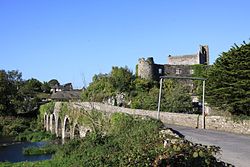Glanworth
| Glanworth Irish: Gleannúir | |
| County Cork | |
|---|---|
 Glanworth bridge and castle | |
| Location | |
| Grid reference: | R757038 |
| Location: | 52°11’13"N, 8°21’22"W |
| Data | |
| Population: | 603 (2016) |
| Dialling code: | 021 |
| Local Government | |
| Dáil constituency: |
Cork East |
Glanworth is a village in County Cork, five miles north-west of the town of Fermoy and some twenty-five miles north-east of Cork city. The 2016 census recorded Glanworth's population as 603.
The village is locally known as 'The Harbour'. This stems from the ninth century invasion of Vikings, who sailed inland as far as the monastery in Glanworth.
The name is from the Irish Gleannúir meaning 'Yew valley'.
Glanworth has a Roman Catholic church, a school, one shop and four pubs.
About the village
Labbacallee wedge tomb, dated to the early Bronze Age, is a mile and a half from Glanworth and is the largest wedge tomb in Ireland.[1]
Glanworth Castle


The 13th-century Glanworth Castle was built beside the River Funshion by the Condon family, Norman settlers who arrived in the Cork area in the twelfth century. The keep and the castle wall remain. The castle is now used mainly as a public walk.
Glanworth Abbey was also built in the 13th century, next to the castle, by the Dominican order. The priory was desecrated in the 16th century. The priory's gable tracery window, now restored, was once part of the Protestant church, which is located in the Catholic graveyard.
Glanworth Bridge was built in the mid-17th century,[2] Glanworth Bridge is a narrow 13-arch bridge, and one of the oldest remaining examples in the region.[3]
Glanworth Mill, built in the mid-19th century, stands at the bank of the River Funcheon, below the Norman castle. Built during the 1840 as part of a famine relief scheme, it is the site of the last remaining reverse undershot water wheel in Ireland.
On film
Several scenes from the 1999 Bob Hoskins film Felicia's Journey were shot on location in Glanworth.[4]
Sport
- Football:
- Glanworth United
- Glanworth Celtic
- Gaelic Athletics: Glanworth GAA
Society
- Scouts: 105th Scout Group
References
- ↑ Megalithic Portal: Labbacallee wedge tomb
- ↑ "Glanworth Bridge, Glanworth, County Cork". Buildings of Ireland. National Inventory of Architectural Heritage. http://www.buildingsofireland.ie/niah/search.jsp?type=record&county=CO®no=20809008.
- ↑ "New life for oldest bridge". Independent News & Media. 12 January 2012. http://www.independent.ie/regionals/corkman/news/new-life-for-oldest-bridge-27090071.html.
- ↑ Leland, Mary (28 August 1998). "Trevor novel to be filmed in Cork". The Irish Times. https://www.irishtimes.com/news/trevor-novel-to-be-filmed-in-cork-1.187251.